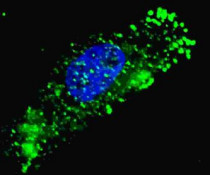ARG54811
anti-ULK1 / ATG1 antibody
anti-ULK1 / ATG1 antibody for ICC/IF,Western blot and Human
Cell Biology and Cellular Response antibody; Cell Death antibody; Metabolism antibody; Neuroscience antibody; Signaling Transduction antibody
Overview
| Product Description | Rabbit Polyclonal antibody recognizes ULK1 / ATG1 |
|---|---|
| Tested Reactivity | Hu |
| Tested Application | ICC/IF, WB |
| Host | Rabbit |
| Clonality | Polyclonal |
| Isotype | IgG |
| Target Name | ULK1 / ATG1 |
| Antigen Species | Human |
| Immunogen | KLH-conjugated synthetic peptide corresponding to aa. 642-672 of Human ULK1 / ATG1. |
| Conjugation | Un-conjugated |
| Alternate Names | ATG1A; Unc51.1; Autophagy-related protein 1 homolog; ATG1; Unc-51-like kinase 1; EC 2.7.11.1; hATG1; UNC51; Serine/threonine-protein kinase ULK1 |
Application Instructions
| Application Suggestion |
|
||||||
|---|---|---|---|---|---|---|---|
| Application Note | * The dilutions indicate recommended starting dilutions and the optimal dilutions or concentrations should be determined by the scientist. | ||||||
| Positive Control | A2058 |
Properties
| Form | Liquid |
|---|---|
| Purification | Purification with Protein G. |
| Buffer | PBS and 0.09% (W/V) Sodium azide |
| Preservative | 0.09% (W/V) Sodium azide |
| Storage Instruction | For continuous use, store undiluted antibody at 2-8°C for up to a week. For long-term storage, aliquot and store at -20°C or below. Storage in frost free freezers is not recommended. Avoid repeated freeze/thaw cycles. Suggest spin the vial prior to opening. The antibody solution should be gently mixed before use. |
| Note | For laboratory research only, not for drug, diagnostic or other use. |
Bioinformation
| Database Links |
Swiss-port # O75385 Human Serine/threonine-protein kinase ULK1 |
|---|---|
| Gene Symbol | ULK1 |
| Gene Full Name | unc-51 like autophagy activating kinase 1 |
| Function | Serine/threonine-protein kinase involved in autophagy in response to starvation. Acts upstream of phosphatidylinositol 3-kinase PIK3C3 to regulate the formation of autophagophores, the precursors of autophagosomes. Part of regulatory feedback loops in autophagy: acts both as a downstream effector and negative regulator of mammalian target of rapamycin complex 1 (mTORC1) via interaction with RPTOR. Activated via phosphorylation by AMPK and also acts as a regulator of AMPK by mediating phosphorylation of AMPK subunits PRKAA1, PRKAB2 and PRKAG1, leading to negatively regulate AMPK activity. May phosphorylate ATG13/KIAA0652 and RPTOR; however such data need additional evidences. Plays a role early in neuronal differentiation and is required for granule cell axon formation. [UniProt] |
| Cellular Localization | Cytoplasm, cytosol. Preautophagosomal structure. Note=Under starvation conditions, is localized to puncate structures primarily representing the isolation membrane that sequesters a portion of the cytoplasm resulting in the formation of an autophagosome |
| Research Area | Cell Biology and Cellular Response antibody; Cell Death antibody; Metabolism antibody; Neuroscience antibody; Signaling Transduction antibody |
| Calculated MW | 113 kDa |
| PTM | Autophosphorylated. Phosphorylated under nutrient-rich conditions; dephosphorylated during starvation or following treatment with rapamycin. Under nutrient sufficiency, phosphorylated by MTOR/mTOR, disrupting the interaction with AMPK and preventing activation of ULK1 (By similarity). In response to nutrient limitation, phosphorylated and activated by AMPK, leading to activate autophagy. |
Images (2) Click the Picture to Zoom In
-
ARG54811 anti-ULK1 / ATG1 antibody ICC/IF image
Immunofluorescence: U251 cells were treated with Chloroquine (50 µM, 16h), then fixed with 4% PFA (20 min), permeabilized with Triton X-100 (0.2%, 30 min). U251 cells were then stained with ARG54811 anti-ULK1 / ATG1 antibody (green) at 1:100 dilution, 2 h at room temperature. Nuclei were counterstained with Hoechst 33342 (blue) (10 µg/ml, 5 min). ULK1 immunoreactivity is localized to autophagic vacuoles in the cytoplasm of U251 cells.
-
ARG54811 anti-ULK1 / ATG1 antibody WB image
Western blot: A2058 cell lysate stained with ARG54811 anti-ULK1 / ATG1 antibody.







